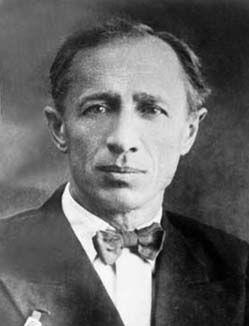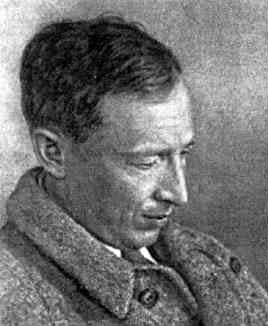<Back to Index>
- Mathematician Nikolai Grigoryevich Chebotaryov, 1894
- Poet Ramón López Velarde, 1888
- Chairman of the Presidium of the Supreme Soviet Yuri Vladimirovich Andropov, 1914
PAGE SPONSOR


Nikolai Chebotaryov (often spelled Chebotarov or Chebotarev) (Russian: Николай Григорьевич Чеботарёв, Ukrainian: Микола Григорович Чоботарьов) (15 June [O.S. 3 June] 1894, Kamianets-Podilskyi, Ukraine, Russian Empire – July 2, 1947, Moscow, USSR) was a noted Russian and Soviet mathematician. He is best known for the Chebotaryov density theorem.
He was a student of Dmitry Grave, a famous Ukrainian and Russian mathematician.
Chebotaryov worked on the algebra of polynomials, in particular
examining the distribution of the zeros. He also studied Galois theory and wrote an influential textbook on the subject titled Basic Galois Theory. On 14 May 2010, the memorial plaque of Nikolai Chebotaryov was unveiled on the main administration building of I.I. Mechnikov Odessa National University.
Nikolai Chebotaryov (or
Chebotarëv) love of mathematics started at about the age of 15
years. His mother was a strong influence on his education and her lack
of knowledge of mathematics seems to have been one of the main reasons
that Nikolai went in that direction. Ill health disrupted his education
and he spent the winter of 1910-11 in Italy with his mother recovering
from pneumonia.
Nikolai entered the University of Kiev in 1912 where he became a student of Grave.
He was awarded his degree in 1916, then a master's degree in 1918. At
this time he earned a living giving private tuition and teaching in
schools.
In 1921 he moved to Odessa to help his
parents, and the following year his father died. In this same year,
1922, Nikolai was to prove the theorem for which he is best known, the
density theorem, which had been conjectured by Frobenius in a paper written in 1880 but only published in 1896. The density theorem generalised Dirichlet's theorem on primes in an arithmetical progression giving a method used by Artin in 1927 in his reciprocity law, a result considered the main result of class field theory.
By 1924 Nikolai had a permanent job in Moscow but he had been appointed to the post Egorov had
been dismissed from for political reasons. It was an unhappy situation
and Chebotaryov resigned after a few months. He returned to Odessa and
found a poorly paid secretarial post. He did manage to attend a meeting
of the German Mathematical Society in Danzig in 1925 where he met Emmy Noether, Hensel and Hasse. After the meeting he met Schur in Berlin then visited Göttingen.
Chebotaryov received his doctorate from the Ukrainian Academy of Sciences with
a doctoral thesis based on his 1922 result, the density theorem. He
became professor at Kazan University in 1928 having been offered posts
at both Kazan and Leningrad. He remained in Kazan all his life.
Chebotaryov worked on the algebra of polynomials, in particular examining the distribution of the zeros. He also studied Galois theory writing a two volume textbook Basic Galois Theory (1934, 1937) and being the moving force in having the first translation of Galois's works into Russian in 1936. Other important work was on Lie groups, and on this topic he wrote the first Russian text Theory of Lie Groups (1940). He also did important work on the inverse Galois problem and the theory of resolvants.